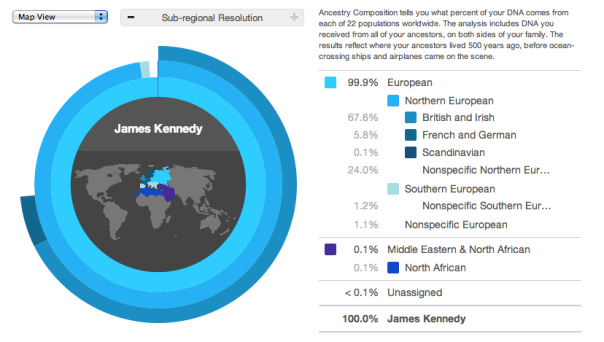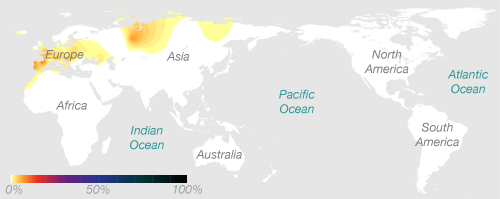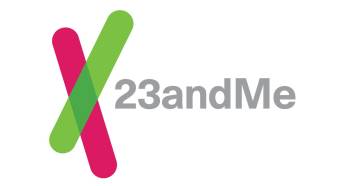Just before Christmas, I spat into a plastic tube and sent it to 23andMe: a genetic testing company in California.
23andMe tests one million SNPs (minor changes) in a person’s genome, many of which are linked with known, inherited traits. Their results reveal a wealth of information about your health and ancestry, ranging from eye colour and bitter taste perception to the presence of major genetic diseases and your extended family tree. Meaningful results are then sent to you by email within a few weeks.
All this is priced well-below cost, at just $99 plus shipping. It was totally worth it. Here’s a list of the 12 most interesting things that 23andMe revealed about me.
1. No carrier status
Fortunately, I carry none of the 48 diseases for which 23andMe tests. That’s good news! None of these diseases will affect me, nor will they be passed on to my children.
2. HIV-resistance: CCR5 +/Δ32
This is awesome—I carry one copy of the HIV-resistance allele! A very small percentage of people are lucky enough to have this allele.
3. Can’t taste bitter: TAS2R38 -/-
The TAS2R38 gene encodes the receptor that detects PROP and related bitter plant compounds. I have a relatively common mutation that is insensitive to PROP. My version of this gene improves the taste of bitter foods—including poisonous ones.
4. Can digest lactose: MCM6 +/+ (regulates LCT)
I don’t like milk, but at least I can digest it. I have two fully-funcional copies of the lactase enzyme, and both will remain active throughout adulthood.
5. Slow caffeine metabolism: CYP1A2.
Caffeine is primarily metabolized by the liver enzyme cytochrome P450 1A2. My version of this enzyme metabolises caffeine slowly (just like 99% of people). I learned that I’m not one of the 1% of people who are virtually insensitive to caffeine.
6. Ancestry
British and Irish: 67.6%; French and German: 5.8% (4 gen); Scandinavian: 0.1% (10 gen); Northern European: 24.0% (2 gen); Southern European: 1.2% (6 gen); Other European: 1.1% (7 gen); Middle Eastern/North African: 0.1% (10 gen); unknown: 0.1%.

I calculated generations by taking the percentages, log base 2 and multiplying by -1.
Most of my ancestors were from “Britain/Ireland”, or “North Europe”, which includes Britain and Ireland. But interestingly, there was a little more diversity than I expected. one of my (great-?)great-grandparents was either French or German (see number 11). Six generations ago, there was someone from South Europe in the family. Ten generations ago, there was one person from Scandinavia, and one person from the Middle East or North Africa.
7. My blood group: A Rh(-) Di(a-b+) K-k+ Kp(a-b+) Jk(a+b+)
I already knew my blood group, but it was interesting to learn that blood groups are a complicated business. For everyday purposes, though, I’m an A-negative.
8. 3.1% Neanderthal DNA (very high)
Neanderthals looked like caricatures of Celts: white, brutish, red-haired and freckled. The average Caucasian has 2.5% neanderthal DNA, and I have 3.1%, putting me in the 98th percentile. It means that I’m “whiter” than most white people.
9. Maternal haplotype: H3 (Western Europe)
H3 is a minority European haplotype found in Western Europe. (Most natives are H1 haplotype.) Over the last 10,000 years, H3 declined in Europe due to random genetic drift, but remains prevalent today in the Basque region (probably because they mixed less frequently with outsiders). There’s almost no phenotypic difference between H1 and H3, so until further research is done, this is merely an interesting fact.

10. Paternal haplotype: R1b1b2a1a2f2 (Ireland)
Obviously. My paternal family is Irish and my paternal haplotype proves it. R1b1b2a1a2f2 is distinctively Irish.
11. One arm of Ch1 is entirely French/German
This is very interesting. I’m British, so while having a little French/German DNA is normal, having it all on one arm of one chromosome indicates that it probably all came from one, recent ancestor (no more than 4 generations ago). Given that French/German DNA is unique in going mostly undetected using 23andMe’s testing methods, and that the possibility of inheriting an entire chromosomal arm halves with each generation, this French/German ancestor was probably a great-grandparent. I didn’t know this.

12. Eight chromosomes contain one arm with no British/Irish DNA at all.
Chromosomes 1, 8, 9, 10, 11, 18, 20, and 22 contain one arm with no British/Irish DNA at all, and one arm with almost 100% British/Irish DNA. Given that one arm is inherited from each parent, this indicates that either I (or each of my parents) had one parent who was purely British/Irish, and one who was a more mixed “Northern European”.

Additionally, 23andMe found 833 distant cousins who have also had their DNA tested. I share great-great-grandparents with the closest of these cousins, but none of them have surnames that I recognise. Some of them live in Wales, but that’s probably just a coincidence. The process of trying to link the family trees, if I do it, would be a long one.
I wanted to do this years ago, but it used to be too expensive: $999 plus a monthly subscription (whatever for?) The price then dropped to $499, $299 then $249 (last year), before finally hitting $99 before Christmas 2012—without any monthly fees. That final price drop prompted me (and nearly a million others) to buy the test.
I highly recommend 23andMe. The data arrives little by little, so there’s something to look into (and reference papers to read) each day. Anyone interested in their own health or ancestry should give it a go.
Related articles
- DIY Your DNA With 23andMe (Now Just $99!) (brit.co)
- Using your 23andMe data: how inbred are you? (blogs.discovermagazine.com)
- How to Analyze Your 23andMe DNA Results (simplerna.com)
- Discover DNA Ancestry and Genetic History with our DNA Test – 23andMe (circadiansabotage.wordpress.com)
